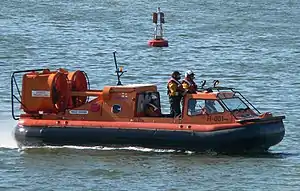H-class lifeboat
H-class rescue hovercraft serve the shores of the United Kingdom as a part of the RNLI inshore fleet. A modified Type 470TD design built by Griffon Hoverwork, they were developed to operate in tidal areas such as Morecambe Bay, where strandings by incoming tides can have fatal consequences; and in waters too shallow for normal craft.
 RNLI Hovercraft H001 Molly Rayner in 2005 | |
| Class overview | |
|---|---|
| Name | H-class rescue hovercraft |
| Builders | Griffon Hoverwork |
| Operators | |
| Preceded by | None |
| Built | 2002–2009 |
| In service | 2002– |
| Completed | 7 (production ongoing) |
| General characteristics | |
| Displacement | 3.86 tonnes |
| Length | 6.88 m (22.6 ft) |
| Beam | 3.36 m (11.0 ft) |
| Draught | N/A |
| Propulsion | 2 x VW 1.9 turbo diesels |
| Speed | 30 knots (35 mph; 56 km/h) |
| Endurance | 3 hours |
| Capacity | 10 |
| Complement | 2-4 |
Hovercraft also operate out of Hunstanton, Hoylake, and Southend-on-Sea stations.
Fleet
| Op. No.[lower-alpha 1] | Name | In service | Principal Station |
|---|---|---|---|
| H-001 | Molly Rayner | 2002– | Relief fleet |
| H-002 | The Hurley Flyer | 2002– | Morecambe |
| H-003 | Hunstanton Flyer (Civil Service No. 450) | 2003– | Hunstanton |
| H-004 | Vera Ravine | 2004– | Southend-on-Sea |
| H-005 | Hurley Spirit | 2005– | Hoylake |
| H-006 | John Russell | 2005– | Relief fleet[1] |
| H-007 | Samburgh | 2009– | Relief fleet[2] |
- Op. No. is the RNLI's Operational Number of the boat.
References
- "RNLI's latest hovercraft named in Poole". RNLI. Retrieved 28 April 2012.
- "Hovercraft funded by generous legacy to be named in special ceremony at RNLI HQ". RNLI. Retrieved 28 April 2012.
This article is issued from Wikipedia. The text is licensed under Creative Commons - Attribution - Sharealike. Additional terms may apply for the media files.